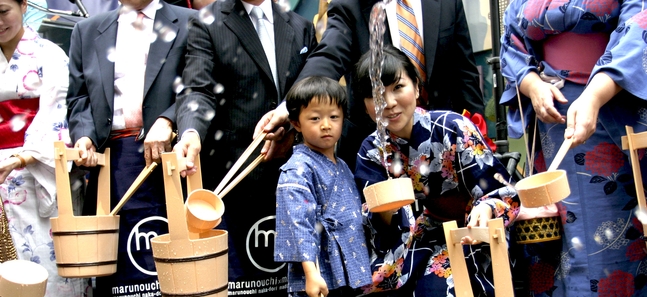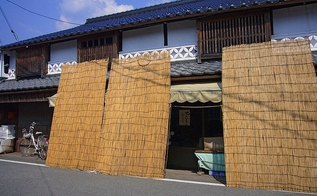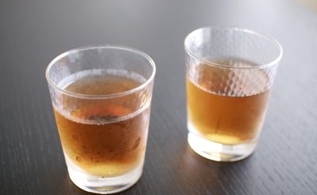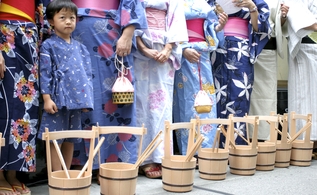Stay cool without air conditioning
Time Out Tokyo readers on how to survive the Summer of Setsuden

Photo by Rubenstein/Flickr
Posted: Wed Jun 29 2011
Staying cool without air conditioning in Tokyo this summer is not going to be easy. With the capital forcing TEPCO's power generators to over 90 percent of its capabilities recently, and the hottest June day on record on June 24 (39.8 degrees in Saitama Prefecture), Japan is already experiencing an uncomfortable summer.
So is it possible to chill out in Tokyo this summer, or are we all doomed to broil? At Time Out Tokyo, we've decided to keep this page as a continuous blog on ingenious ways to stay cool without air conditioning. It's a community effort, and with readers regularly checking in from all over the world, we want to hear cooling methods - serious, whacky; traditional, fresh from the brainbox - that you've been employing in your community. Just drop us a line via our Twitter account, our Facebook account or on this email address. If you have pics, even better. We hope to hear from you soon.

A flurry of overnight email activity from our Japanese readers reminds us that telling ghost stories in Japan is considered to be a traditional way to cool down. The idea is that a good Japanese ghost story will make you shiver, hence the fact that the spooky months in this country are the summer months (the Obon 'Festival of the Dead' obviously plays some part in this, too).
If you're looking for ways to get your freak on with a good Japanese ghost story, we recommend going on one of the Haunted Tokyo Tours, or grabbing yourself a copy of of Yokai Attack! by Tokyo-based husband and wife team, Matt Alt and Hiroko Yoda. You might even fancy a wonder through a graveyard – it's an odd thing to be saying, but Yanaka Cemetery is our morbid spot of choice.
'Do what?'
'Kumquat,' just as we said. 'All over your neck.'
@shexisxgone claims that this particular ancient Eastern medical method works a treat. Simply slap on some kinkan (kumquat) juice and feel your temperature drop. We've been unable to find any convincing data online to support this (no data whatsoever, to tell the truth), but it seems this heat-beating remedy is well known in Japan, and indulged enough to warrant a kumquat medicinal shop.
Is 'cool as a kumquat' an actual phrase? It is now.

Ah, the ideas are flowing in now. Rather than dumping your bedclothes in the freezer, @kazkos writes to say that her family uses bamboo sheets. It's not instantly obvious from the picture, but these are for rolling out onto your futon and lying on top of, rather than beneath. The wood is naturally low in temperature, and the spaces between the bamboo pieces help to circulate air. They're also easy to scrub down in a traditional Japanese bath, making them another great eco-friendly item. The Japanese staff at Time Out Tokyo insist that they're comfortable, and we've certainly heard of worse (see the bedclothes in the freezer link above).

The ultimate eco-friendly cooling device, tried and tested over hundreds of years (they're mentioned regularly in The Tale of Genji, Genji presumably being a man who liked his eco-friendly comforts), the simple, stylish sudare were tweeted to us by @tonotype. Ultra simple, they're little more than bound bamboo arranged as a kind of lean-to curtain. Predictably, such simplicity can run to huge expense, though our tweeter suggests getting them from Daiso, the ¥100 store, just like he does.

Although they're becoming more and more common abroad, as far as we can tell the magical 'hiepita' cooling gel sheets that you stick on your forehead are originally a Japanese phenomenon. @sarita_sy07 tweets to remind us that they work equally well when stuck to the back of your sweating neck on a scorching day. Commonly, these hiepita items use a menthol-based product, which actually harks back to a more traditional approach - mint having long been recognised as a cooling food in many cultures (just think of those mint-choc-chip ice creams you loved as a child!)
This one might seem a little eccentric, but @Kishakishi says the best way to stay cool at night is to pre-freeze your bedclothes. Her method is to douse the futon, duvet, bed sheets and pillow lightly with water, whack them all into a plastic bag and then shove them into the refrigerator for two hours before going to sleep. Et voila, a frigid bed for a hot night.
To us, it sounds a little labour intensive...and we have to ask: Duvet? In a Japanese summer? Get rid of that and you may find half your battle won before you've even touched the freezer.
This one's for the women: @yodamina writes to tell us her methods for keeping her face cool without damaging her carefully applied makeup. Very simply, she wraps a small icepack in a handkerchief and then dabs softly at her skin. For men, we reckon this could be a good way of getting around the sticking your neck under a cold tap dilemma we confronted earlier.
One anonymous reader points out that some of the most eco-friendly and ancient cooling methods known to Japan are the furin wind chimes. Usually made of glass or steel, these delicate little things hang near the garden or on the porch and ring out in a light breeze. Locals believe that the sound cools them down - most probably a psychological response rather than a genuinely chilling one.
The Time Out Tokyo staff have been experimenting with these sounds this morning. Our Japanese members are convinced the sound lowers their temperature, while out western staff members are convinced a cow is coming down the lane. Obviously the power of the furin depends largely on where you were brought up.
Interestingly enough, you can trigger your own frigid reaction with this newly developed Furin iPhone app.
Blacko Muiri from Ireland writes to ask why Japan keeps trying to promote Super Cool Biz, when it produced the ideal summer garment hundreds of years ago in the humble (but very cool) jinbei. 'I don't understand why this year's cool biz is about Hawaiian shirts in the office,' he rants. 'Surely the salarymen of Japan should be going to work in jinbei, made by obachan in Tohoku perhaps.'
If any Japanese man (or woman) would like to comment on this, drop us a line on this email address.

According to findings by Mitaka City local government, growing 'green curtains' from gourd seeds can reduce the heat inside your house by as many as two degrees. With this in mind, they've distributed 400 pots of gourd amongst Mitaka citizens, and are hoping that nurseries and after-school centres will adopt the practice across the city soon.
Rakuten are currently doing a fine trade in green curtain necessaries, with a sufficiently low-rent, beer-swilling image character to encourage their efforts. Ganbatte, Goya-Kun!
Our nicely bearded friend @HanakoTanako Tweets to say that running your wrists under a cold tap for 10 seconds (per wrist) cools her body sufficiently for up to an hour. One of our office members is trying it out for us as we speak.
How is it, James?
'Well, my wrists feel nice...'
Indeed, a little research shows that the wrists are considered to be 'cooling spots' for the body, along with your elbows and neck (though running your neck under the office cold tap may not be advisable - depends how flexible both your boss and your neck are).

'Drinking mugi-cha (barley tea) is like cold beer while at work,' Tweets @marymacinblack, and indeed, it's not the first we've heard of this. While barley tea is known in Japan as mugi-cha, it can be found in Korea as 'boricha' and in China as 'dàmàichá' or 'màichá'. It is thought to lower the body temperature, as well as easing sore throats, cleansing the blood, acting against digestive disorders and even preventing certain cancers. We'd love to see sound statistics backing these claims; at best, we can agree that it's extremely refreshing, while the lack of caffeine means you can keep chugging it all day long.

Japanese readers will know the uchimizu tradition well, and as community activities go, there couldn't be a better one this summer. Incorporating togetherness, cleanliness and cooling without air conditioning (this is a centuries-old practice after all), uchimizu involves spilling water around the streets of your neighbourhood in an effort to chill the ground, to settle the dust, and to prompt a good old chinwag with your neighbours. Eco groups in the country have, in recent years, called for the use of recycled water, and there are occasionally mass eco-friendly uchimizu events, with thousands of people splashing about for the good of mankind. This activity was suggested by @Neguko, who runs Negla in Yanaka.
Tweets
- About Us |
- Work for Time Out |
- Send us info |
- Advertising |
- Mobile edition |
- Terms & Conditions |
- Privacy policy |
- Contact Us
Copyright © 2014 Time Out Tokyo














Add your comment